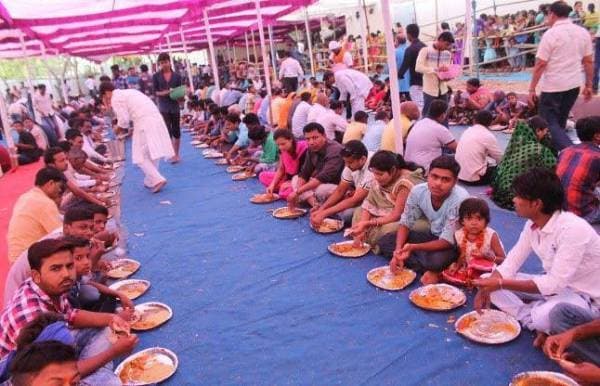Langer

Langar was already prevalent in our tradition. In fact, Mahan Kosh ascribes the origin of Langar word to Sanskrit word Analgrah. Nath Hindu Saints used to have Bhandara which was borrowed 1st by Muslim Sufis then by Sikhs. Other regional variants of Bhandara/Lanagar are Dham in Shivalik Hills, Jagg, Mahabhoj, Annadanam, Sadya in Kerala temples as early as the Gupta empire had Dharma Satras for feeding entire community.
Source: https://twitter.com/RajSharma1857/status/1261495398998388737
Annadanam is a practice eulogized in Vedas, Upanishads, Bhagavad Gita & other Hindu scriptures. It is regarded as greatest form of Seva. The same practice is prevalent all over India by different regional names like Dham, Bhandara, Satra, Jagg, Pritibhoj, Mahabhog, Sadya etc.
Similarly, Langar term is prevalent in Punjab, Himachal & Jammu; the ‘origin’ of which is wrongly ascribed to Sikh Guru Arjan or Sufi Sheikh Farid. Reality is Langar like practices were already prevalent among Hindu communities like Shaivite Nath Jogis & Vaishnavite Bairagis in an institutionalised form in their shrines. Sikh historian Gurinder Singh Mann is of similar view. Another Sikh historian Sirdar Kapur Singh even calls it “Aryan institution” which is true as is evident from numerous references of Priti bhojas performed on regular basis after Yajnas & other Hindu rituals in Ramayan & Mahabharat. Both Sirdar Kapur Singh & Kahn Singh Nabha derive the etymology of term langar from Sanskrit word Analgraha. This clears that Langar is a Hindu practice which was first adopted by Muslim Sufis from Hindus & then by Sikhs. Now some of the Muslim Sufis & Sikh intellectuals ascribe “Anti Caste” Character of Langar to themselves. However the argument is absurd as the Nath Jogis from whom they borrowed this concept never observe any distinctions on basis of caste, gender or age. The institutional form of Annadanam was prevalent in ancient India as is evident from numerous Satras (temple kitchens) which were constructed along with temples or Mathas especially in Gupta empire. This practice still exists in Hindu temples all over India.
Another absurd claim made by Sikh historians in order to prove the uniqueness in the concept is that “Nath Jogis begged food & Sufis received revenue free grants”. This is baseless as Sikh Gurdwaras themselves maintain a donation box. Historically Sikh Gurus have also received donations and gifts from various local rulers. The greatest example of which is Gurdwara Bangla Sahib which was actually a mansion of Hindu Rajput King Raja Jai Singh which was donated to eighth Guru Har Krishan Ji by the Hindu ruler. The statement about Nath Jogis begging food for Bhandara or Langar is also false. In a typical Nath Jogi Bhandara, devotees contribute their share which is known as “Ralla”. The major contribution of course comes from the shrine itself. Similarly, Vaishnav institutes have historically set up gaushalas and Satras for Bhandaras/Langars. Bhandara tradition was revived by Sri Dhar Pandit (the devotee of Mata Vaishno Devi) who performed Bhandara after Devi Puja and Kanya Puja. In conclusion, The concept of Langar (Annadanam), its institutional form, its non sectarian character, Seva Bhaava, community participation & the etymology of word Langar all owe a Hindu origin.
Source: https://twitter.com/RajSharma1857/status/1261884285960716288